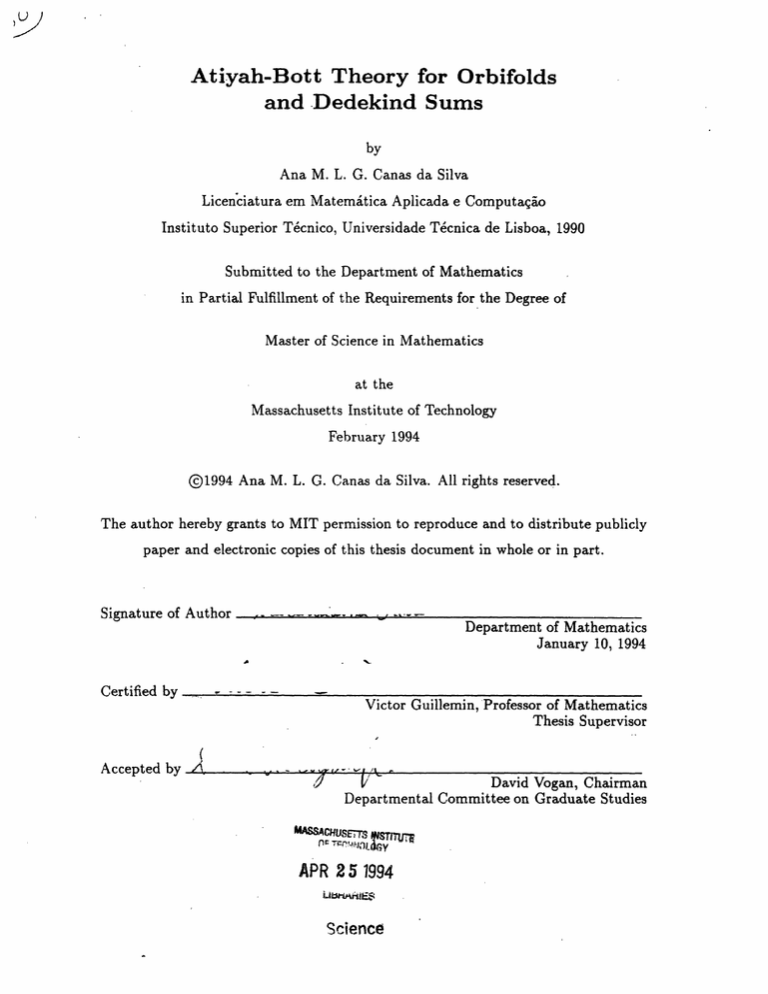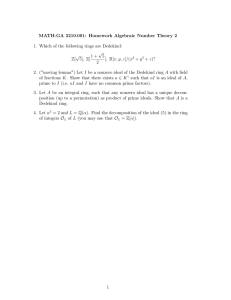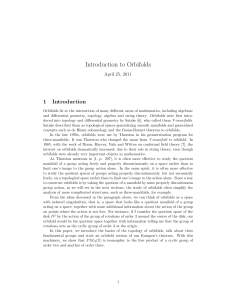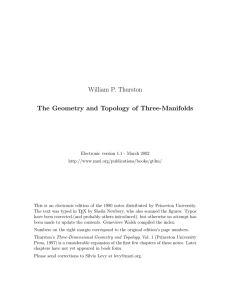Atiyah-Bott Theory for Orbifolds and Dedekind Sums
advertisement

Atiyah-Bott Theory for Orbifolds
and Dedekind Sums
by
Ana M. L. G. Canas da Silva
Licenciatura em Matemitica Aplicada e Computaao
Instituto Superior T6cnico, Universidade Tecnica de Lisboa, 1990
Submitted to the Department of Mathematics
in Partial Fulfillment of the Requirements for the Degree of
Master of Science in Mathematics
at the
Massachusetts Institute of Technology
February 1994
@1994 Ana M. L. G. Canas da Silva. All rights reserved.
The author hereby grants to MIT permission to reproduce and to distribute publicly
paper and electronic copies of this thesis document in whole or in part.
Signature
ofAuthor
, . v .....
Department of Mathematics
January
Certified by
Accepted by A
-
10, 1994
Victor Guillemin, Professor of Mathematics
Thesis Supervisor
6' ,
{"David
/
Vogan, Chairman
Departmental Committee on Graduate Studies
APR 2 5 1994
Lgi
Science
Atiyah-Bott Theory for Orbifolds
and Dedekind Sums
by
Ana M. L. G. Canas da Silva
Submitted to the Department of Mathematics
on February 1, 1994 in Partial Fulfillment
of the Requirements for the Degree of
Master of Science in Mathematics
ABSTRACT
This paper shows how to deduce the reciprocity laws of Dedekind and Rademacher,
as well as n-dimensional generalizations of these, from the Atiyah-Bott formula, by
applying it to appropriate elliptic complexes on a "twisted" projective space. This
twisted projective space is obtained by taking the quotient of C" - 0 by the action
p(w)(Zl1 ,. -. ,Zn) = (Wql
,qZn),
E C, qi E Z+ ,
where the qi's are mutually prime. Since this is not a manifold, it is necessary to
adapt Atiyah-Bott to the setting of orbifolds.
Thesis Supervisor: Victor Guillemin
Title: Professor of Mathematics
2
Contents
5
1 Fixed point formula for orbifolds
1.1
The case of good orbifolds ........................
5
1.2
The case of general orbifolds .......................
6
2 Application to a twisted projective space
8
2.1
General formula ..............................
8
2.2
The limit case ...............................
10
2.3
The case n = 3 and reciprocity laws ..................
2.4
Generalized Dedekind sums .......................
2.5
Counting
lattice
points
. . . . . . . . . . . . . . . .
3
.
11
13
. .......
15
Introduction
Let Y be the "twisted" projective space obtained by taking the quotient of C ' - 0
by the action
p()(Zl,...
,zn) = (ql'z
1,.
.,q"z,),
E C,qi E Z+ ,
where the qi's are mutually prime. We will show in this paper how to deduce the
reciprocity laws of Dedekind and Rademacher, as well as n-dimensional generalizations of these formulas, from the Atiyah-Bott formula by applying it to appropriate
elliptic complexes on Y. Since the twisted projective space, Y, is not a manifold,
this will require our adapting Atiyah-Bott to the setting of orbifolds. The version
of Atiyah-Bott needed for our purposes is described in section 1 and the number
theoretic applications of it, mentioned above, are discussed in section 2.
4
1
Fixed point formula for orbifolds
1.1
The case of good orbifolds
Let X be a compact complex manifold of complex dimension n, G a finite group acting
on X with action r: G x X - X. The quotient space Y = X/G is consequently a
good orbifold.
Define the Dolbeault cohomology of Y to be the G-invariant cohomology of X,
H'(Y) = HG(X), where HG(X) are the G-invariant subspaces of Hi(Y),i = 1,...,n.
A holomorphic G-equivariant function f: X - X induces a quotient map
and f:
Hb(X)
f:
Y-
Y
Hb(X) from the pull-back on G-invariant forms.
We will define the Lefschetz number of the mapping f to be
n
L(f) = Z(-1)t trace (ft: Hb(X) -- H(X)).
i=1
We will need the following elementary result:
Theorem.
1.1 Let V be a vector space and p : G -
Aut(V) a representation of a
finite group G on V. IfL : V - V is a G-equivariant linear map, then
1
trace (L: VG-- VG) = II E trace (p o L) :V -- V),
where VG is the space of G-fixed vectors in V.
By the above Theorem 1.1, we have
L(f) =
I' E trace ((Tgro f) : Hi(X) --+ H(X)).
i-1
GI EG
Supposing, in addition, that f: Y
-+
Y has only non-degenerate isolated fixed points,
or equivalently, that rg o f has only non-degenerate isolated fixed points for all g E G,
we can compute
-(-1)'trace((rgof) : H'(X) - H'(X))=
i=1
E
sgndet(l-d(rgof)p)
(1)
{pl(rgo)(p)=p}
by the standard Lefschetz fixed point theorem [GP].
Theorem.
1.2 Under the above conditions we have:
L(f)
1.2
C
E
- C=
gIEG{pl(-gof)(p)=p}
sgn det (1 -d(r, o f)p).
The case of general orbifolds
In order to write formula (1) in a form which makes sense for general orbifolds Y that
are not globally quotients of the form X/G (X a manifold, G a finite group), let us
determine the actual contribution of a fixed point q of f
Y = X/G, let Pi,P2,
,Pk
Y -
Y. Still assuming
be the pre-images of q in X. Replacing, if necessary, f
by r o f for some g E G, we can assume f(pl) = pi. Let Gpi be the stabilizer group
of pi in G. Thus, the contribution of q to the Lefschetz number is:
1
E
=1 {gGl(rgol)(Pi)=pi}
=l
sgn det (1 - d(r9 o f)p,)
or
G1i,
sgn det (1 - d(r, o f)p,)
I i=1 9EGpi
since f is G-equivariant. In fact,
Z sgn det (1 -
sgn det (1 - d(rg o f)p,
f
=
d(rg o f)p)
gEGpl
iEGpi
because the Gp,,are conjugate and f is G-equivariant, i.e.
d(rTg O Tg rg. 1 o f)rg;(p) = d(rg O f)p.
6
Therefore, the contribution of q to L(f) is
1
k*
I GI
sgn det (1-d(rgof)pl)
gEGp
or
,Z
1
IGP1
sgn det (1 -d(T
o f)p,).
|IEGpl
This motivates the following result (which we will give a proof of elsewhere):
Let
:Y
Y be a holomorphic function from a compact complex orbifold Y to itself,
having only non-degenerate isolated fixed points ql,...,q,,,.
Define the Lefschetz
number of f to be
n
L(f) = Z(-1)itrace (f : H'(Y) _-_H(Y)).
i=l
Taking orbifold charts around each of the qi's, for a neighborhood Y of qi, there are:
X and G such that Yi= X/G,
a pre-image pi of qi,
an isotropy group Gi, and
a locally well-defined lift fi of f.
Claim: We have
L(f) =
m
1
sgn det (1 - d(g o fi)pi)
i=1 7G I
EGi
reducing again a global topological invariant to a finite number of local differential
computations.
Remark:
If L
-+
G is a G-invariant holomorphic line bundle and H'(X,L)
the
cohomology groups obtained by tensoring the Dolbeault complex with L, we can
compute the alternating sum of the traces of fl on Hb(X, L) by a sum over the fixed
points of I: Y -- Y of the terms
1
trace (g o fi
Lp Lp))
Gi gEG, det (1 - d(rg o fi)p,)
7
[AB.
2
Application to a twisted projective space
2.1
General formula
Take Y to be the orbifold obtained by dividing Cn - 0 by the group C* where C*
acts by
P(,)(Z,,.· .,
,n)= (1
Z1,. . W. Z,),
qi E Z +
.
Assuming ql, ... , qn mutually prime, the orbifold Y is non-singular except at the n
points:
.... [0,...,0, 1]
[1,0,...,0], [01,0...,0],
Z/q, respectively, and thus may be singular. (Notice
which have stabilizers Z/ql,...,
that when qi = 1, the corresponding point is non-singular.)
The standard diagonal action of S' on C - 0,
ft(Zi,. .,Zn) = (e27rit1,.l e2 ritZn)
.
.
induces an action ft on the orbifold Y (since it commutes with p). As long as t Z 0,
its fixed points are only
[1,0,...,0], [0,1,0,...,0],...,
[0,...,0,1].
Consider the holomorphic line bundle L over Y associated with the representation
: C*
i.e.,
#-Aut(C),
L = [(Cn -0) x C]/{[z,-7(w)c]
Y(W)c = WdC,
[p(w)z,c],w E C}.
In order for L to be well-defined on Y, the condition
qi1 d,i = 1,..., n,
is required. We will write d = . ql
or equivalently,
... qn.
8
ql . qnId
PROOF.
The projection of the hyperplane z, = 1 of C - 0 on Y contains only
one of the singular points, namely [0,..., 0, 1]. The subgroup of C' which fixes this
cross-section is the group of q roots of unity that acts as p(w)(z 1 ,...,z,._.,l)
(wQ zl,. . .wn-1
Zn-1l,1) ,
=
while y(w)c = wdc on the fiber of L. We have
0,1), y()c]
[(0,...,
[p(w)(O,..., 0,1), c]
It
II
[(0,..., , O1), wdc]
[(0,...,0, 1), c]
hence, in order for L to be well-defined at [0,..., 0, 1] we need q,,d.
Similarly for the other singular points. Q.E.D.
On the cross-section
Zn =
1, rq = p(e2rq ) acts by
Tq(21***Z- 1e)
..
=1 (e27riqn-1q
e2r
i
qqZn _l
whereas
z
ft(Tz,..
2 itz...
=1)(eft(Z
,
(e2nit(lL
,e2ritz
1n,e2 rit) A-,(e2it(
1) = (e e
Zn-1,
)Zl,.
Z-n,2it(l-).
en
We define an action of S1 on L induced by letting S1 act trivially on the second factor
of (Cn
-
O0)x C:
0,0,1), =[(0,..., 0,
et[(0...,
e2
), c] [(0, ....0,1),
e2Rtc],
so the action of e2"'it E S1 on the fiber of L above [0,..., 0, 1] is given by multiplication
by e
27rit d
q.
Interpreting these results in terms of the lift to the smooth Cn-l covering of this
cross-section (which roughly amounts to ignoring the last coordinate
Zn
when it's 1),
we conclude that
2
Tq a (ft)n
=
(ft)n
=
=
multiplication
rit
by
e
Lo...o)
multiplication
by e
9
q
: L(o.,0)
-
L(o...o)
L(o,...,o)
d(qo(ft))(o...o) = diag(
2iqd(
diae2rit(l)zl,
. ,etet(-1)ZnI nZ1
, (f ,)e 0)1d')iag(e
q
9
Summing over the qn-th roots of unity, w = e
qn, q = 0, 1,..., qn-1, the contribution
of [0,... ,0, 1] to the Lefschetz number of ft is
1 q-1
e27ritd
qn q=0 rIzmin
q=O
Hmn(
1
-e2=ri(l1-2m
a a )t eri2
- eq
e ,n
)
Similar computations yield similar results for the other fixed points. Adding all these
-n
-11qr 2rit
d
contributions up we finally get for the global Lefschetz number of it:
L(ft) =
qr q=OnImr(1_-2ai(l-qm)t
On the other hand, the Lefschetz number of
ft
(2)
1
9r1
r=l
.e
(2)
was defined to be
n-1
L(ft)= Z(-l )'tace(] : H'(Y, L) - H'(Y, L)).
i=l
We assume Hi(Y, L) = 0 for i > 0. As for H°(Y, L) this is the global holomorphic
sections of L and these are just the monomials on C" z,
...
z
n
which transform
under the action of C* according to the law
(l
Z)ml
· · · (Wqn n)mn = wdml
. . Zmn
and hence qlml+. . .+qnm = d. Thus the dimensionof H°(Y, L) is the number # of
integerlatticepoints (ml,...,m,) satisfying qlml+...+qnmn = d, ml,... ,m, > 0.
We will compute this dimension in the next section by studying the limit of (2) as
t -- 0.
2.2
The limit case
Although our formula doesn't hold for t = 0 since fo leaves all points fixed, we can
compute its limit as t --. 0. Notice that the dimension of H°(Y, L) is independent of t.
10
So, when t --+ 0,
z - I - e 'i(
t-r= qq0
=mr(1
n
#= limZn
1
qr-1
= Ez-E
r=l qr =l
q19~~r-l
2rit
e
1
e 'i )
n1e27rit
I
2ri qqr
e
rHmnr(l -
)t
))
+
t-o
d
e
r(
li m
(3)
where the last limit can be computed writing a Laurent series for each summand:
an-l,_
l
tntn-I tr
+
al,1
t
+ ao,
+
..- ..
As t -, 0 the sums of the negative terms in these series must cancel and we end up
with
•
r=l
1 qr-1
(ao,r +
qr q=l
rlmr(1 -
e2 ri
a)
as the number of non-negative integral solutions of the equation
qlml + ... + qnmn = d.
Now we can write
n
1 qr-=
r=1 qr
1
=1
1
Hm r(1 - e2' i
)
1
r=
r q' =l,, l
fjmr(j _-
and relate this to generalized Dedekind sums according to [HZ] (see section 2.4).
2.3
The case n = 3 and reciprocity laws
For n = 3 (the first interesting case), formula (3) reads:
#{(ml, m 2, m3) E Z 3 lqlml + q2 m2 + q3 m3 = d, ml, m ms
2,
3 1 qr-
r=
E
q 1
1
lnmr(1- e
+lim
27riUm
qr
1
e
_
B
A
11
0} =
e2ri(1
t
- e2i(
qr )
t-0 r=lqr In,(l
)
3
'
Let's deal with each of these terms A and B in turn.
A:
We can write
3
1
rl
A=-
Setting
q3 - kl q2 mod ql,
q
1
imr(
r 7 9r=1,1 701
- k2q3 mod q2,
A =
Z -
r1 Qm)
-
q2
= k3 q1 mod q3, we find
1
A =r~l--qr E (1- 77)(1
- -) rr1ll
s(krq,,)
4q,
779r=11r01
by the definition of s(k, q,) according to [RG, p.151. But by the Rademacher reciprocity law [HZ, p. 9 ],6
3~~~
2
q
] s(kr,qr)= I
12
r=
When q3 = 1 we can take kl
=
+2
+
q+:+
2
1
1
q2 '
4
qlq2q3
q2, k2 = q, k 3 = 0 and the formula reduces to
1
Zs(k, qr)= s(q2, q1)+s(ql,q2)= -
3
12
q2
r=l1
1
+ qlqlqq+
q2
q
-
which is just the Dedekind reciprocity law [RG].
B:
eWt
1
Each summand in B is of the form qr
term in the Laurent expansion is
ao = -4
qr,
(1--ewlt)(1-ew2 t
Iw
lw
1
2 wl
2
2 w lw
2
W2
1 W1
2
12 w 2
) for which the constant
1w 2
12wl
Therefore,
3
1/1
B= Eao,r=--+
r=1
4q!
1
+
q2
2
(qi + q2 + q3) +
12
jq1l2q3
2
+
1 q~2
4
12
q+q+q
12
+
qlq~q3
1+1)
Next we should compute the left-hand side to see if it agrees. We have
# {(ml,
m 2, m3 ) E Z3 Jqimi
+ q2 mn2 + qsm3 = d = lqlqq3, in,
12
2,
m3
0}
2
+
Iq q2
#{(mi, m 2 ) E Z2 [Iqml+ q2m 2 = (lqtq2 - m3 )q3 , mI,m
=-
2
> O}
m3 =0
1qj q (Iql2 -
3)q3
+ 1 -6(m3) ,
q, q2
M3=0
where
[x] denotes the greatest integer not exceeding x,
e(m 3 ) = 0 or 1, with e(m 3 ) = 0 whenever m 3 is a multiple of ql or q2, and
e(m 3 ) + e(lqlq2 - m3) = 1 when m 3 is neither a multiple of q, nor of q2.
Therefore,
lql q2
E (m3)= 2I#{integers in [0, Iqjq2]neither
multiples of ql, nor of q2} -
(q-1)(q2-1)
2
m3 =0
Also, since
(p - 1)(q + 1
k=1
JI
for p, q mutually prime,
2
we get
lql q2
(lqlq2- 3)q3
12
2
m3 =0
*qlq2q3 +
(q3 -qlq2
+ 1)-
We conclude that
#{(ml, m 2 , m 3 ) E Z3 lqlml + q2 m2 + q3m 3 = d = qlq2q3, i,m,
12
2, m 3
> 0}
1
= 2- qlq2q3+2 (ql+q2 + q3) + 1
and, hence, in this case (3) is equivalent to Rademacher reciprocity law.
2.4
When
Generalized Dedekind sums
= 0, i.e., d = 0 and the line bundle L is trivial, formula (3) reduces to
n
r=l
1
qr- 1
1
qr=l lmr((1 -e
rI
r )
13
+lt-Or=l qr
1
lmr(1 - e 2
rr -(1q)t
r
1
r=1
qr
=- 11
1-limE
1
VImr(1 -
=j7
lrm)
mpr(1 --
t- r= qr
rs
(4)
92r(Iq
)
where the last limit can be evaluated by the Laurent series argument. Letting
, 7 7Er1,
~1
r) =
6(qr; q, i
1
- -qm)
7qr=l 77,1 lmor(
n
1
an(ql,..., qn) =
r),
q, i
-n(qr;
r=l qr
when n = 2, 3, 4, 5 we explicitly find the following generalized reciprocity laws.
Cn(ql,. . .,qn)
n =2
1 -
-+-
2
q2j
1
n =3
n=4
q,
4 (q
1-
81
1\
1 q + q2 + q3
+-- +1)-1
q2
1
qlq2q3
+-+-+-
1qiQ1
1
1
1
q2
q3
q4
1 (ql+ q2 + ql
+ + q3
24
q3q4
q2q4
n=5
q~+q~+q3
12
q3
1
q-
1
ql + q4
q2 + q3
q2 + q4
q2q3
qlq 4
qlq3
1
4-8 qlq
ij<k2 q3q4q5
~
____
1
1
144
qlq2q3q4q5
q
q
s~a~s;~T<;6
i<3
i<) 2
i
q3+q4
*
1
1
720
qlq 2 q3 q4 q5
Remark: It is possible to write the limit term (correspondingto B in section 2.3) in
terms of Bernoulli numbers Bn defined by
Bnt = t
E
et -1
n=0 n!
Bo = 1,
B
1
'
1
2
= 3...
This is why the coefficients in the final expressions for the ac's resemble products of
Bernoulli numbers.
14
1(l-l
kkq,
ql.l.
.,qn)
On the other hand, [HZ, p.100-101] gives results for generalized Dedekind sums of
type 6, for n odd, namely
E 1E
r=l
where
-1-
r icot
k=l m1r
qr
qr
(5)
... qn
ql
is a certain polynomial in n variables which is symmetric in its variables,
In-l
even in each variable, and homogeneous of degree n - 1. Formula (5) is related to the
previous 6,'s and an's by
1
qr -
1
r
7rkq,
*= qr k=l mgr
1
qr
____
r=1 qr rqr=l,1 *l mor
1
n
1
m -
n-l
(-2)i
r=1 Q 77qr=1,771j=0 IC{1l...n}\r,#I=j riI(1n-1
n
)
1
-2)j
j=O
71 1
r=l qr
IC{(1...n\r,#I=j
6j+l(q; q, i E I)
n
=
(-2)
j -1
j=l
E
JC{1...n},#J=j
aj(qi,i E J).
When n = 3, 5
13
12 (ql, q 2 , q3)
1
/4(ql q2
q
=
i=1
q5)
7
q
q4
-90
5
i=
q
and it is easily seen that (5) is in agreement with our results for a,, n = 2, 3, 4, 5. In
some sense (4) extends (5) to the case of n even.
2.5
Counting lattice points
Considering again a general line bundle (i.e., arbitrary d, or 1), we see that formula
(3) provides an expression for the number # = #n(ql,. . , q,) of integer lattice points
(mi, ..., mn) satisfyingqlml + ... + qnM, = d, ml,..., mn > 0, namely
nqr-1
#n(ql,...,
q)=
E'
r=l
E-
qr qq=1
n
+ lim1
m9r(r
t-
An
1
2irit
Q
l mmr(1
e
_
Bn
15
g'i(6)
e2qi(
9 )t(
As in the case d = 1 = 0 (see formula (4)),
n
1 qr-1
-lim
n
1
r=l qr q=1 -mi#r(1
-
1
t-0
e 21qr)
1r
1
Hm1rO
-
_ e.26q, -2
and thus both An and Bn can be computed from the Laurent series argument. For
n
5 we get the following results.
#1
=
1
#2
=
1+1
#3
#4
=2 qlq2q3+ 2 (q + q2+ q3)+ 1
13
=
6
12
(
4
+ q+
4
+
q
qlq2q3q4(ql
q32+
q2
+
+ q2 + q3 + q4)
3qlq2± 3qq3
12
#5 =
(I
24
+ 12
+
3q1q4 + 3q2q3 + 3q2q 4 +
(IIqj) ( q) +2~4
12(r qi)
3q
3q
4
)+ 1
q2+3* Ei<j qiqj)
S
I
qqi
24
+ik3
qiqjqk
+1
Working out #n(ql,. .. , q,) directly for each n, by decomposing into sums generalizing
the procedure in section 2.2, e.g.
lqlq2q3q4
#4 =
X=O
#{qlml + q2m2 = x} . #{q3m3 + q4m4 = lqlq2q3q4- },
and equating similar powers of I in (6), we can gradually find many other interesting
formulas.
We conclude that it is easy to deduce Number Theory results from Atiyah-Bott
adapted for orbifolds, by applying it to specific examples.
16
References
[AB] M. Atiyah and R. Bott, Notes on the Lefschetz Fixed Point Theorem for Elliptic
Complexes, Harvard University, Cambridge, 1964.
[GP] V. Guillemin and A. Pollack, Differential Topology, Prentice-Hall, Englewood
Cliffs, 1974.
[HZ] F. Hirzebruch and D. Zagier, The Atiyah-Singer Theorem and Elementary Number Theory, Publish or Parish, Inc., Boston, 1974.
[RG] H. Rademacher and E. Grosswald, Dedekind Sums, The Carus Mathematical
Monographs 16, The Mathematical Association of America, Washington, 1972.
17








